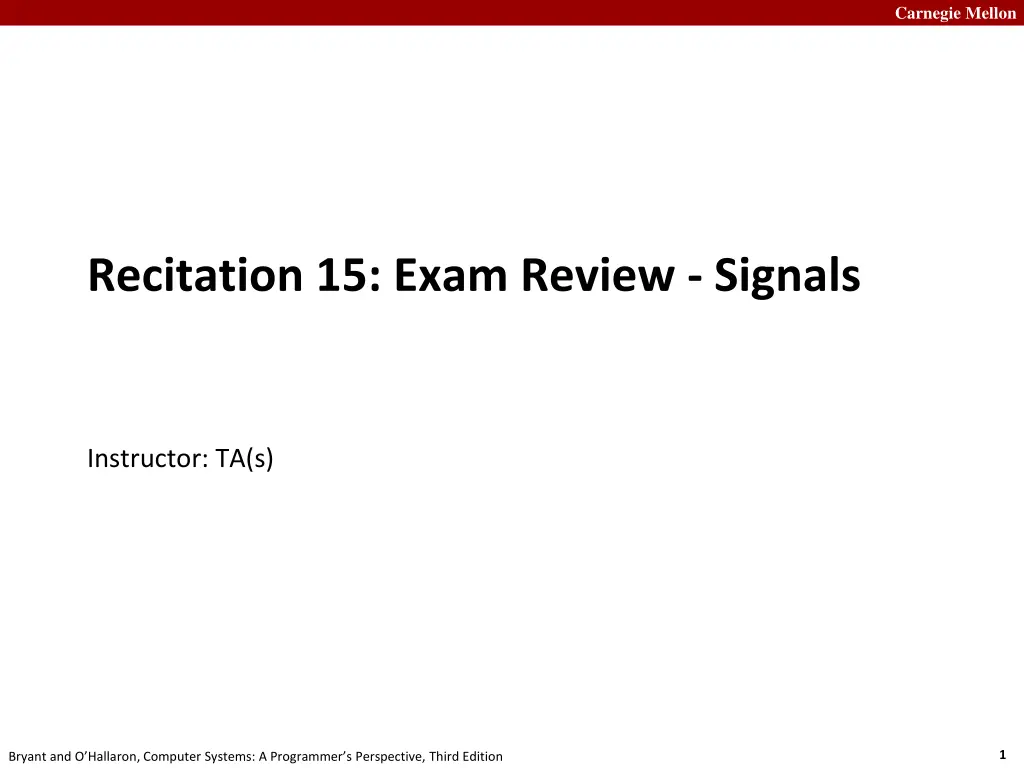
Carnegie Mellon Signals and Handling Overview
Explore signals and signal handling concepts for computer systems exam review at Carnegie Mellon University. Learn about the proxylab, final exam details, signal handling reminders, and signal blocking techniques detailed in the course material.
Download Presentation

Please find below an Image/Link to download the presentation.
The content on the website is provided AS IS for your information and personal use only. It may not be sold, licensed, or shared on other websites without obtaining consent from the author. If you encounter any issues during the download, it is possible that the publisher has removed the file from their server.
You are allowed to download the files provided on this website for personal or commercial use, subject to the condition that they are used lawfully. All files are the property of their respective owners.
The content on the website is provided AS IS for your information and personal use only. It may not be sold, licensed, or shared on other websites without obtaining consent from the author.
E N D
Presentation Transcript
Carnegie Mellon Recitation 15: Exam Review - Signals Instructor: TA(s) 1 Bryant and O Hallaron, Computer Systems: A Programmer s Perspective, Third Edition
Carnegie Mellon Outline Proxylab Final Exam Signals 2 Bryant and O Hallaron, Computer Systems: A Programmer s Perspective, Third Edition
Carnegie Mellon Proxylab Proxylab is due Tuesday (or late by Friday) Worth almost a letter grade Submit early autolab may compile / run differently 3 Bryant and O Hallaron, Computer Systems: A Programmer s Perspective, Third Edition
Carnegie Mellon Final Exam Details Signups Coming Full review session coming Eight problems Nominal Time is 90-120 minutes, but you get five hours Problems cover the entire semester, focus on second half Report to the room TA will verify your notes and ID TAs will give you your exam server password Login via Andrew, then navigate to exam server and use special exam password 4 Bryant and O Hallaron, Computer Systems: A Programmer s Perspective, Third Edition
Carnegie Mellon Signals and Handling Reminders Signals can happen at any time Control when through blocking signals Signals also communicate that events have occurred What event(s) correspond to each signal? Write separate routines for receiving (i.e., signals) What can you do / not do in a signal handler? 5 Bryant and O Hallaron, Computer Systems: A Programmer s Perspective, Third Edition
Carnegie Mellon Signal Blocking We need to block and unblock signals. Which sequence? pid_t pid; sigset_t mysigs, prev; sigemptyset(&mysigs); sigaddset(&mysigs, SIGCHLD); sigaddset(&mysigs, SIGINT); // need to block signals. what to use? // A. sigprocmask(SIG_BLOCK, &mysigs, &prev); // B. sigprocmask(SIG_SETMASK, &mysigs, &prev); if ((pid = fork()) == 0) { // need to unblock signals. what to use? /* A. sigprocmask(SIG_BLOCK, &mysigs, &prev); * B. sigprocmask(SIG_UNBLOCK, &mysigs, &prev); * C. sigprocmask(SIG_SETMASK, &prev, NULL); * D. sigprocmask(SIG_BLOCK, &prev, NULL); * E. sigprocmask(SIG_SETMASK, &mysigs, &prev); 6 Bryant and O Hallaron, Computer Systems: A Programmer s Perspective, Third Edition
Carnegie Mellon Signal Blocking cont. Someone implemented the wrong choices. Which signals are now blocked? pid_t pid; sigset_t mysigs, prev; sigemptyset(&mysigs); sigaddset(&mysigs, SIGCHLD); sigaddset(&mysigs, SIGINT); sigprocmask(SIG_SETMASK, &mysigs, &prev); // What is blocked? if ((pid = fork()) == 0) { sigprocmask(SIG_BLOCK, &prev, NULL); // What is blocked? 7 Bryant and O Hallaron, Computer Systems: A Programmer s Perspective, Third Edition
Carnegie Mellon Signal Queuing How many times is the handler invoked? void handler(int sig) { ...} ... sigset_t mysigs, prev; signal(SIGUSR1, handler); sigemptyset(&mysigs); sigaddset(&mysigs, SIGUSR1); sigprocmask(SIG_BLOCK, &mysigs, &prev); kill(getpid(), SIGUSR1); kill(getpid(), SIGUSR1); sigprocmask(SIG_SETMASK, &prev, NULL); 8 Bryant and O Hallaron, Computer Systems: A Programmer s Perspective, Third Edition
Carnegie Mellon Signal Delivery What can be printed? When is an unblocked signal delivered? // Assume SIGINT is unblocked pid_t pid = fork(); if (pid > 0) { kill(pid, SIGINT); printf( A"); } else { kill(getppid(),SIGINT); printf( B"); } See http://www.cs.cmu.edu/~213/oldexams/final-f10.pdf 9 Bryant and O Hallaron, Computer Systems: A Programmer s Perspective, Third Edition
Carnegie Mellon Signal Delivery What can be printed? When is a blocked signal delivered? sigset_t mysigs, prev; sigemptyset(&mysigs); sigaddset(&mysigs, SIGINT); sigprocmask(SIG_BLOCK, &mysigs, &prev); pid_t pid = fork(); if (pid > 0) { kill(pid, SIGINT); sigprocmask(SIG_SETMASK, &prev, NULL); printf( A"); } else { kill(getppid(),SIGINT); sigprocmask(SIG_SETMASK, &prev, NULL); printf( B"); } 10 Bryant and O Hallaron, Computer Systems: A Programmer s Perspective, Third Edition
Carnegie Mellon Signal Delivery Child calls kill(parent, SIGUSR{1,2}) between 2-4 times. What sequence of kills may only print 1? Can you guarantee printing 2? What is the range of values printed? int counter = 0; void handler (int sig) { counter++; } int main(int argc, char** argv) { signal(SIGUSR1, handler); signal(SIGUSR2, handler); int parent = getpid(); int child = fork(); if (child == 0) { /* insert code here */ exit(0); } sleep(1); waitpid(child, NULL, 0); printf("Received %d USR{1,2} signals\n", counter); See http://www.cs.cmu.edu/~213/oldexams/final-s07.pdf 11 Bryant and O Hallaron, Computer Systems: A Programmer s Perspective, Third Edition
